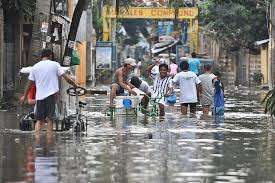Typhoon Ketsana (Ondoy) in 2009 caused catastrophic flooding in Metro Manila and nearby areas, impacting millions and leading to widespread damage and loss.
ADVERTISEMENT

Table of Contents

Typhoon Ketsana (Ondoy)
Typhoon Ketsana (Ondoy) is remembered as one of the most catastrophic weather events in the history of the Philippines. On September 26, 2009, Ondoy struck with relentless rainfall, registering approximately 455 millimeters (17.9 inches) in just 24 hours—the heaviest recorded in more than 40 years. This unprecedented downpour caused severe flooding that submerged over 80% of Metro Manila, with some areas experiencing water levels reaching rooftops.
The typhoon’s impact was devastating. Thousands of homes were destroyed or damaged, and transportation was brought to a standstill as roads became impassable rivers. The economic toll was significant, with damage estimated at around ₱11 billion (approximately $237 million at the time). Essential services such as power, water, and communication were disrupted, further compounding the crisis.
In addition to Metro Manila, other provinces in Central Luzon, CALABARZON, and parts of Northern Luzon also experienced extensive flooding. Emergency response efforts were overwhelmed due to the sheer scale of the disaster. Many residents were stranded on rooftops for hours or days, awaiting rescue by emergency services and volunteer groups.
The aftermath of Typhoon Ondoy spurred nationwide discussions on climate resilience, urban planning, and flood management. The disaster exposed inadequacies in existing drainage systems and highlighted the vulnerability of informal settlements in low-lying areas. In response, the government and private sectors launched recovery initiatives and urban planning reforms to mitigate future flood risks. The tragedy also reinforced the importance of community solidarity, as people came together to support each other during the challenging period.
Typhoon Ketsana’s legacy serves as a powerful reminder of the need for robust disaster preparedness, effective emergency response systems, and comprehensive urban planning to withstand the challenges posed by extreme weather events.
Typhoon Ketsana (Ondoy): A Comprehensive Overview
I. Introduction
Typhoon Ketsana, known locally as Ondoy, struck the Philippines on September 26, 2009, leaving an indelible mark on the country’s history. This powerful tropical storm brought record-breaking rainfall that led to catastrophic flooding, primarily in Metro Manila and surrounding provinces. The disaster not only exposed the vulnerability of urban infrastructure but also highlighted the resilience and solidarity of the Filipino people in the face of extreme adversity.
II. Meteorological Details
Ketsana began as a relatively weak tropical storm in the Western Pacific but quickly gained strength as it approached the Philippine landmass. It brought unprecedented rainfall, measuring approximately 455 millimeters (17.9 inches) within a 24-hour period. This rainfall was the highest recorded in over four decades, equivalent to a month’s worth of rain falling in just a single day. The storm’s trajectory swept through central Luzon, leaving behind a trail of destruction.
III. Areas Affected
Metro Manila bore the brunt of Typhoon Ondoy’s impact. Floodwaters rapidly inundated streets, homes, and commercial centers, submerging more than 80% of the city. Neighborhoods that had never experienced severe flooding before were caught off guard as water levels reached rooftops in some areas. The storm’s impact was particularly severe in low-lying areas and informal settlements, where inadequate drainage systems exacerbated the disaster.
Other Affected Provinces,
Such as parts of CALABARZON and Central Luzon, also suffered extensive damage. Entire communities were submerged, with some residents forced to seek refuge on their rooftops for days as they waited for rescue. The scale of flooding disrupted transportation and made many areas inaccessible, hindering emergency response efforts.
IV. Human and Economic Impact
The human toll of Typhoon Ketsana was staggering. Over 460 lives were lost, and more than 4.9 million people were affected by the flooding. Thousands of families were displaced, seeking refuge in evacuation centers that quickly became overcrowded and under-resourced.
The economic damage
was similarly significant, with estimates reaching approximately ₱11 billion (around $237 million at the time). The typhoon severely impacted homes, businesses, and critical infrastructure, leaving a lasting economic burden. The agricultural sector faced massive losses due to flooded farmlands, further compounding the economic stress on affected communities.
Disruption of Essential Services
Was widespread. Power outages and communication breakdowns made it difficult for emergency services to coordinate rescue and relief efforts. Many residents were left without access to clean water and essential supplies, further intensifying the crisis.
V. Emergency Response and Challenges
The initial response to Typhoon Ondoy involved a collaborative effort between the government, military, and local authorities. Rescue operations were launched swiftly, but the scale of the disaster overwhelmed available resources. Volunteer groups and non-governmental organizations (NGOs) stepped in to assist, providing food, clothing, and temporary shelter for those in need. However, the response faced significant challenges, including impassable roads, insufficient rescue equipment, and the sheer number of people needing assistance. Many residents were stranded on rooftops for hours or even days, waiting for rescue amidst rising floodwaters.
VI. Lessons Learned and Reforms
The devastation wrought by Typhoon Ondoy revealed critical flaws in the Philippines’ infrastructure and urban planning. The storm underscored the inadequacies of the city’s drainage systems and flood control mechanisms, prompting calls for comprehensive upgrades. In the aftermath, the government launched several flood mitigation projects, including the construction of additional water retention facilities and improvements to existing drainage networks.
Policy changes
Were implemented to bolster disaster preparedness. Enhanced early warning systems were developed, and the country adopted a more proactive approach to disaster risk reduction. This included training programs for local government units and public awareness campaigns aimed at educating citizens on emergency preparedness and response.
Community resilience
Was another key takeaway from Typhoon Ondoy. Stories of neighbors helping one another, volunteers wading through waist-deep water to deliver supplies, and community-led relief efforts became hallmarks of the response to the disaster. These examples reinforced the importance of community solidarity in times of crisis.
VII. Long-Term Impact and Legacy
The legacy of Typhoon Ketsana has been its role as a catalyst for improved disaster management in the Philippines. The storm highlighted the urgent need for sustainable urban development and robust infrastructure capable of withstanding extreme weather events. The lessons learned from Ondoy have informed subsequent disaster response protocols and reinforced the value of comprehensive planning and preparedness.
The disaster also brought the issue of climate change to the forefront. The increasing frequency and intensity of typhoons have underscored the need for both national and international efforts to mitigate climate change and adapt to its impacts. Sustainable practices, reforestation, and stronger environmental policies have become key components of the ongoing dialogue around disaster risk management.
Conclusion
Typhoon Ketsana (Ondoy) was a turning point in how the Philippines approached natural disasters. Its impact—both immediate and long-term—served as a reminder of the importance of preparedness, resilient infrastructure, and community unity. The country’s response to subsequent typhoons has been shaped by the hard lessons learned during Ondoy, highlighting the need for continuous improvement and adaptation in the face of an increasingly unpredictable climate.
Disclaimer
This content is provided for informational purposes only and does not constitute professional advice. While every effort has been made to ensure the accuracy of the information presented, the author and publisher assume no responsibility for any errors, omissions, or actions taken based on the content. For comprehensive guidance on disaster preparedness, response, and recovery, readers are encouraged to consult relevant experts, government advisories, and official resources.
About Author
Kween Yulo is a seasoned SEO writer with 15 years of experience, specializing in diverse niches across the digital landscape. Her expertise spans various industries, including gaming, e-commerce, finance, travel, and lifestyle. Known for crafting engaging, optimized content, Kween’s writing is tailored to boost search rankings and enhance user engagement. Her deep understanding of SEO trends, keyword strategies, and audience behavior has made her a trusted content creator for businesses seeking to strengthen their online presence. Kween’s versatility and dedication to quality make her an asset in any digital content strategy.


